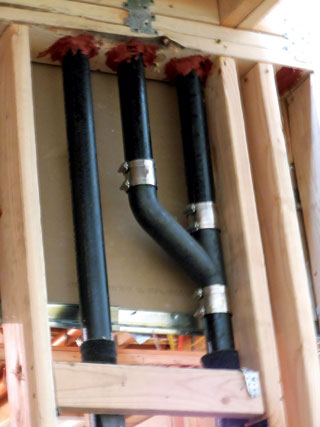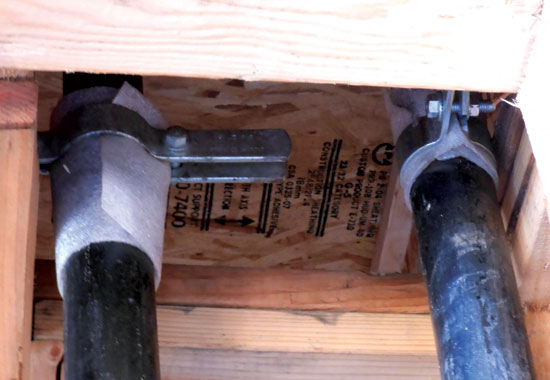Mid-Rise Wood Construction
How to Frame with Wood
In addition to selecting the appropriate framing technique, designers of wood buildings must consider factors such as shrinkage, differential movement, and seismic requirements.
Platform Framing and Balloon Framing
There are three common types of framing for wood construction`. For Type VA buildings, where exterior walls require a one-hour fire-resistance rating, traditional platform framing is usually used, where the joists sit on top of the double top plates of the wall. Balloon framing is where the joists hang off the ledger that is attached to the structural studs that frame the building. In modified or semi-balloon framing, the floor framing hangs off the double top plates; it is often used as an alternative to platform-framed structures for both Type VA and Type IIIA construction.

Photo: KC Kim, GB Construction
Built to achieve LEED Platinum certification, New Genesis Apartments in Los Angeles, California, designed by Killefer Flammang Architects, is a mixed-use and mixed-income wood-frame building with commercial retail space.
Shrinkage
Regardless of the framing type, IBC Section 2304.3.3 requires that designs for buildings over three stories take into account the fact that wood shrinks as it dries. Shrinkage continues until wood reaches its Equilibrium Moisture Content (EMC), which averages 8-12 percent moisture content for most structures in the U.S. The Western Wood Products Association (wwpa.org) offers a technical guide that includes formulae for calculating shrinkage for different wood species across the country as well as a downloadable shrinkage estimator.
“Shrinkage calculations aren't complex,” says Kam-Biron, “but it's an area designers aren't always familiar with, and it can be challenging to detail for differential movements between two different materials and overall shrinkage.” The shrinkage effects must be considered for horizontal framing members (width or thickness) in the wall (top/sill plates) and floor (joists) design. Wood is anisotropic, meaning the dimensional change in wood is unequal in different directions. In most softwoods, radial shrinkage (across growth rings) is approximately 4 percent and tangential shrinkage (parallel to growth rings) is approximately 8 percent from green (unseasoned) to typical EMC for structures in the U.S. Longitudinal shrinkage (parallel-to-grain) for vertical framing members is generally negligible and does not affect building performance. Therefore, the majority of shrinkage will occur in the top plates, sill plate and sole plates, and possibly the floor joists—depending on how the floor framing members are framed to the wall. If the framing is balloon-framed or modified balloon-framed, then sawn lumber joists won't play a huge role in overall movement from shrinkage because balloon framing, unlike platform framing, does not accumulate shrinkage over all floors. “Unseasoned (green) sawn lumber will shrink more compared with seasoned (dried) lumber,” says Cheung. “Shrinkage should be considered for wood-frame buildings over three stories. The good thing about wood is that it will dry naturally.” Ways to minimize shrinkage include (among others) specifying kiln dried lumber, letting the wood dry during construction before closing in the walls, and using products and systems such as pre-engineered metal-plate connected wood trusses for floor and/or roof framing, and manufactured wood products (laminated veneer lumber, I-joists, etc.). I-joist floor systems are dimensionally stable and offer minimal inter-floor shrinkage.

Plumbing joints with pipes nested in joint to allow for vertical movement of structure

Plumbing sleeve connected to structure with foam wrap to allow vertical movement of structure
Additionally, there can be some overall settlement of the building that may occur due to gaps in the building construction that can contribute to the overall vertical movement. Some contractors will distribute the dead load throughout the height of the building and allow the building to acclimate to the environment and/or air dry prior to installation of the drywall, thus allowing the building to naturally settle.









